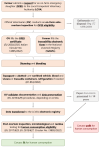Occurrence and Reasons for On-Farm Emergency Slaughter (OFES) in Northern Italian Cattle
- PMID: 40805029
- PMCID: PMC12345588
- DOI: 10.3390/ani15152239
Occurrence and Reasons for On-Farm Emergency Slaughter (OFES) in Northern Italian Cattle
Abstract
On-farm emergency slaughter (OFES) is employed when cattle are unfit for transport but still suitable for human consumption, thereby ensuring animal welfare and reducing food waste. This study analysed OFES patterns in Northern Italy, where a large cattle population is housed but information on the practice is rarely analysed. A total of 12,052 OFES cases from 2021 to 2023 were analysed. Most involved female cattle (94%) from dairy farms (79%). Locomotor disorders were the leading reason (70%), particularly trauma and fractures, followed by recumbency (13%) and calving-related issues (10%). Post-mortem findings showed limbs and joints as the most frequent condemnation sites (36%), often linked to trauma. A significant reduction in OFES cases occurred over time, mainly due to fewer recumbency and calving issues, likely reflecting stricter eligibility criteria introduced in 2022. Weekly variations, with peaks on Mondays and lows on Saturdays, suggest that logistical constraints may sometimes influence OFES promptness. These findings suggest that on-farm management and animal handling could be improved further to reduce welfare risks and carcass waste. Due to the lack of standardised data collection and regulatory harmonisation, a multi-country investigation could improve our understanding of this topic and inform best practice.
Keywords: animal welfare legislation; ante-mortem inspection; cattle mortality; locomotion disorders.
Conflict of interest statement
The authors declare no conflicts of interest.
Figures





Similar articles
-
Prescription of Controlled Substances: Benefits and Risks.2025 Jul 6. In: StatPearls [Internet]. Treasure Island (FL): StatPearls Publishing; 2025 Jan–. 2025 Jul 6. In: StatPearls [Internet]. Treasure Island (FL): StatPearls Publishing; 2025 Jan–. PMID: 30726003 Free Books & Documents.
-
Interventions to improve safe and effective medicines use by consumers: an overview of systematic reviews.Cochrane Database Syst Rev. 2014 Apr 29;2014(4):CD007768. doi: 10.1002/14651858.CD007768.pub3. Cochrane Database Syst Rev. 2014. PMID: 24777444 Free PMC article.
-
Sexual Harassment and Prevention Training.2024 Mar 29. In: StatPearls [Internet]. Treasure Island (FL): StatPearls Publishing; 2025 Jan–. 2024 Mar 29. In: StatPearls [Internet]. Treasure Island (FL): StatPearls Publishing; 2025 Jan–. PMID: 36508513 Free Books & Documents.
-
Elbow Fractures Overview.2025 Jul 7. In: StatPearls [Internet]. Treasure Island (FL): StatPearls Publishing; 2025 Jan–. 2025 Jul 7. In: StatPearls [Internet]. Treasure Island (FL): StatPearls Publishing; 2025 Jan–. PMID: 28723005 Free Books & Documents.
-
Systemic pharmacological treatments for chronic plaque psoriasis: a network meta-analysis.Cochrane Database Syst Rev. 2021 Apr 19;4(4):CD011535. doi: 10.1002/14651858.CD011535.pub4. Cochrane Database Syst Rev. 2021. Update in: Cochrane Database Syst Rev. 2022 May 23;5:CD011535. doi: 10.1002/14651858.CD011535.pub5. PMID: 33871055 Free PMC article. Updated.
References
LinkOut - more resources
Full Text Sources

